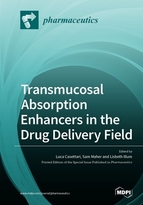Transmucosal Absorption Enhancers in the Drug Delivery Field
A special issue of Pharmaceutics (ISSN 1999-4923).
Deadline for manuscript submissions: closed (15 January 2019) | Viewed by 144111
Special Issue Editors
Interests: drug delivery systems; biopolymers; cosmetics; surfactants
Special Issues, Collections and Topics in MDPI journals
Interests: lipid based formulations; surfactants; oral formulation of advanced drug delivery systems; toxicokinetics; permeation enhancers
Interests: transmucosal drug delivery systems; nasal drug delivery; transmucosal absorption enhancers
Special Issue Information
Dear Colleagues,
Development of strategies to assist the movement of poorly permeable molecules across biological barriers has long been the goal of drug delivery science. In the last three decades, there has been an exponential increase in advanced drug delivery systems that aim to address this issue. However, most proprietary delivery technologies that have progressed to clinical development are based on permeation enhancers (PEs) that have a history of safe use in man. This Special Issue entitled “Transmucosal Absorption Enhancers in the Drug Delivery Field” aims to present the current state-of-the-art in the application of PEs to improve drug absorption. Emphasis is placed on identification of novel permeation enhancers, mechanisms of barrier alteration, physicochemical properties of PEs that contribute to optimal enhancement action, new delivery models to assess PEs, studies assessing safety of PEs, approaches to assist translation of PEs into effective oral dosage forms and combining PEs with other delivery strategies (e.g., nanoparticles).
We invite research scientists from the pharmaceutical/food industry or academia to submit original research articles, review articles or commentaries. This Special Issue will provide researchers with an up to date resource on how PEs are used to address sub-optimal permeability.
Prof. Luca Casettari
Dr. Sam Maher
Prof. Lisbeth Illum
Guest Editor
Manuscript Submission Information
Manuscripts should be submitted online at www.mdpi.com by registering and logging in to this website. Once you are registered, click here to go to the submission form. Manuscripts can be submitted until the deadline. All submissions that pass pre-check are peer-reviewed. Accepted papers will be published continuously in the journal (as soon as accepted) and will be listed together on the special issue website. Research articles, review articles as well as short communications are invited. For planned papers, a title and short abstract (about 100 words) can be sent to the Editorial Office for announcement on this website.
Submitted manuscripts should not have been published previously, nor be under consideration for publication elsewhere (except conference proceedings papers). All manuscripts are thoroughly refereed through a single-blind peer-review process. A guide for authors and other relevant information for submission of manuscripts is available on the Instructions for Authors page. Pharmaceutics is an international peer-reviewed open access monthly journal published by MDPI.
Please visit the Instructions for Authors page before submitting a manuscript. The Article Processing Charge (APC) for publication in this open access journal is 2900 CHF (Swiss Francs). Submitted papers should be well formatted and use good English. Authors may use MDPI's English editing service prior to publication or during author revisions.
Keywords
- Transmucosal absorption enhancers
- Barriers to mucosal absorption
- Mechanisms of drug absorption enhancement
- Permeability enhancement of small molecules and biomolecules
- Advanced transmucosal formulations for drug delivery









